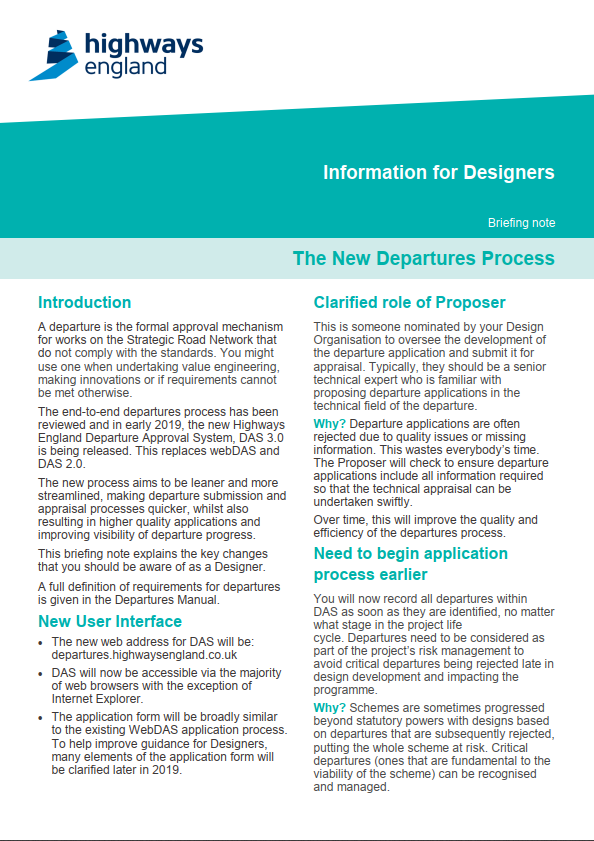Introduction
A departure is the formal approval mechanism for works on the Strategic Road Network that do not comply with the standards. You might use one when undertaking value engineering, making innovations or if requirements cannot be met otherwise.
The end-to-end departures process was reviewed and in early 2019, the new National Highways Departures Approval System, DAS 3.0 was released. This replaced WebDAS and DAS 2.0.
DAS 3.0 process aims to be leaner and more streamlined, making departure submission and appraisal processes quicker, whilst also resulting in higher quality applications and improving visibility of departure progress.
This briefing note explains the key changes that you should be aware of as a Designer.
A full definition of requirements for departures is given in the Departures Manual.
Back to topNew User Interface
- The new web address for DAS will be: departures.highwaysengland.co.uk
- DAS will now be accessible via the majority of web browsers with the exception of Internet Explorer.
- The application form is similar to the previous WebDAS application process. To help improve guidance for Designers, many elements of the application form have been clarified in the Departures Manual as well as guidance on DAS.
Clarified role of Proposer
This is someone nominated by your Design Organisation to oversee the development of the departure application and submit it for appraisal. Typically, they should be a senior technical expert who is familiar with proposing departure applications in the technical field of the departure.
Why? Departure applications are often rejected due to quality issues or missing information. This wastes everybody’s time. The Proposer will check to ensure departure applications include all information required so that the technical appraisal can be undertaken swiftly.
Back to topNeed to begin application process earlier
You will now record all departures within DAS as soon as they are identified, no matter what stage in the project life cycle. Departures need to be considered as part of the project’s risk management to avoid critical departures being rejected late in design development and impacting the programme.
Why? Schemes are sometimes progressed beyond statutory powers with designs based on departures that are subsequently rejected, putting the whole scheme at risk. Critical departures (ones that are fundamental to the viability of the scheme) can be recognised and managed.
Early on, a Technical Specialist at National Highways can give an initial view of critical departures. If they anticipate that the principles of the departure are feasible, they can give provisional agreement. Otherwise, they can indicate changes that would need to be made for approval to be recommended. This prevents the design progressing too far with an unacceptable departure and allows the designs to be changed as early as possible.
Constructive early engagement with the Technical Specialist, facilitated by the new Technical Partner team, will provide better assurance that a departure can be approved and what evidence will be required to support.
Back to topRejection and return for rework
Previously, in any instance where a departure application could not be approved, it would be rejected. There is now the additional option for it to be returned to the Designer for rework.
Applications will still be rejected where the departure would not be acceptable, even with improvements.
If the application cannot be appraised due to quality and completeness issues, this will be returned for rework. This will be a leaner process, as the subsequent resubmission process can be streamlined.
It also allows better reporting on where quality issues exist to support continuous improvement activities.
Back to topWill the process take longer?
The entire departures process has been reviewed and the changes that are being introduced are intended to:
- Reduce the end-to-end time taken to determine a departure.
- Reduce the total amount of effort required to develop and appraise a departure application, including by reducing the proportion of applications that are rejected on quality grounds.
- Minimise the number of departures that are submitted due to out of date or unclear requirements (facilitated through the DMRB review and proposer role).
Further guidance
The Departures Manual is available to assist you with applications. It gives a full overview of the departures application process.
Videos showing key aspects of the departures application process are available on the National Highways Departures channel on YouTube.
If you have any queries, please contact departures@nationalhighways.co.uk
Back to topPDF Download

This briefing note is also available as a PDF. Click here to download.
Right first time checklist

DAS Checklist for Designers – Click Image.
Back to top